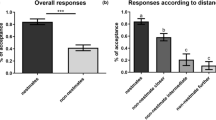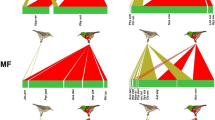Abstract
Three groups of specialist nectar-feeders covering a continuous size range from insects, birds and bats have evolved the ability for hovering flight. Among birds and bats these groups generally comprise small species, suggesting a relationship between hovering ability and size. In this study we established the scaling relationship of hovering power with body mass for nectar-feeding glossophagine bats (Phyllostomidae). Employing both standard and fast-response respirometry, we determined rates of gas exchange in Hylonycteris underwoodi (7 g) and Choeronycteris mexicana (13–18 g) during hover-feeding flights at an artificial flower that served as a respirometric mask to estimate metabolic power input. The O2 uptake rate (V˙ o2) in ml g−1 h−1 (and derived power input) was 27.3 (1.12 W or 160 W kg−1) in 7-g Hylonycteris and 27.3 (2.63 W or 160 W kg−1) in 16.5-g Choeronycteris and thus consistent with measurements in 11.9-g Glossophagasoricina (158 W kg−1, Winter 1998). V˙ o2 at the onset of hovering was also used to estimate power during forward flight, because after a transition from level forward to hovering flight gas exchange rates initially still reflect forward flight rates. V˙ o2 during short hovering events (<1.5 s) was 19.0 ml g−1 h−1 (1.8 W) in 16-g Choeronycteris, which was not significantly different from a previous, indirect estimate of the cost of level forward flight (2.1 W, Winter and von Helversen 1998). Our estimates suggest that power input during hovering flight P h (W) increased with body mass M (kg) within 13–18-g Choeronycteris (n = 4) as P h = 3544 (±2057 SE) M 1.76 (±0.21 SE) and between different glossophagine bat species (n = 3) as P h = 128 (±2.4 SE) M 0.95 (±0.034 SE). The slopes of three scaling functions for flight power (hovering, level forward flight at intermediate speed and submaximal flight power) indicate that: 1. The relationship between flight power to flight speed may change with body mass in the 6–30-g bats from a J- towards a U-shaped curve. 2. A metabolic constraint (hovering flight power equal maximal flight power) may influence the upper size limit of 30–35 g for this group of flower specialists.
Mass-specific power input (W kg−1) during hovering flight appeared constant with regard to body size (for the mass ranges considered), but differed significantly (P < 0.001) between groups. Group means were 393 W kg−1 (sphingid moths), 261 W kg−1 (hummingbirds) and 159 W kg−1 (glossophagine bats). Thus, glossophagine bats expend the least metabolic power per unit of body mass supported during hovering flight. At a metabolic power input of 1.1 W a glossophagine bat can generate the lift forces necessary for balancing 7 g against gravitation, whereas a hummingbird can support 4 g and a sphingid moth only 3 g of body mass with the same amount of metabolic energy. These differences in power input were not fully explained by differences in induced power output estimated from Rankine-Froude momentum-jet theory.
Similar content being viewed by others
Author information
Authors and Affiliations
Additional information
Accepted: 10 November 1998
Rights and permissions
About this article
Cite this article
Voigt, C., Winter, Y. Energetic cost of hovering flight in nectar-feeding bats (Phyllostomidae: Glossophaginae) and its scaling in moths, birds and bats. J Comp Physiol B 169, 38–48 (1999). https://doi.org/10.1007/s003600050191
Issue Date:
DOI: https://doi.org/10.1007/s003600050191




